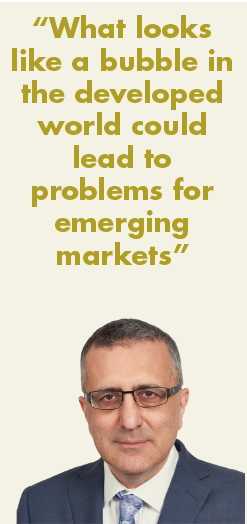Although the prospect of a trade war is the tail risk that has most worried fund managers since mid-2018, other potential perils look more threatening. In particular the problems associated with the extended bout of extraordinary monetary policy have yet to become fully apparent.
One area that has received insufficient attention is the impact on emerging markets of ultra-loose monetary policy in the advanced economies. There are good reasons to believe that what looks like a bubble in the developed world could lead to problems for emerging markets.
This is leaving aside the problems facing certain emerging markets. It is widely accepted that Argentina, Turkey and Venezuela face specific challenges of their own, but these are for discussing on another day. The question here is whether emerging markets more generally are under threat. Some are undoubtedly more vulnerable than others but arguably there is a broader systemic weakness.
It is not hard to see a mechanism through which difficulties could arise. Ultra-low rates in the developed world create an incentive for portfolio flows to switch to emerging markets in search of higher returns.
In the short run such a shift can, of course, benefit investors. In the desperate search for yield they can do better than they would do otherwise. But in the longer term it is a different matter.

Perhaps the most obvious risk is that of a sudden withdrawal of surplus capital when an interest rate rise in the West looks imminent. This was already apparent in the ‘taper tantrum’ of May 2013 when investors in several emerging markets panicked when Ben Bernanke, then chairman of the US Federal Reserve, hinted that the US would start reducing its monetary stimulus. Five emerging markets with large current-account deficits – Brazil, India, Indonesia, South Africa and Turkey – were labelled the ‘fragile five’ as a result.
The longer-term risk is that excessive capital inflows will lead to emerging market currencies rapidly appreciating and stoking up inflation. An overvalued currency could in turn make exports more expensive and make imports cheaper. That could then lead to a widening current account deficit.
Some of these pitfalls are alluded to in the latest Global Financial Stability Report from the International Monetary Fund. Its chapter on emerging and frontier markets points out that “falling rates in advanced economies have supported debt portfolio flows to emerging markets and a decline in external credit spreads, which has led to stretched valuations in some cases, particularly for lower-rated issuers”.
These and other key risks facing the investment world in 2020 will be discussed in more detail in the December issue.
Daniel Ben-Ami, Deputy Editor
daniel.ben-ami@ipe.com













